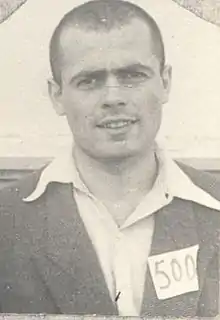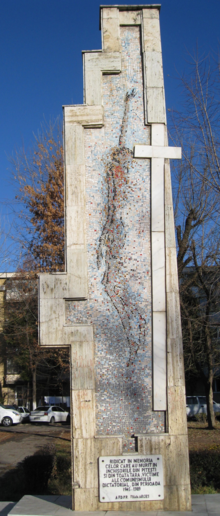Eugen Țurcanu
Eugen Țurcanu (8 July 1925 – 17 December 1954) was a Romanian criminal who was executed for his role in the notorious re-education experiment at Pitești Prison. He was sentenced to seven years of imprisonment as a member of the fascist Iron Guard, where he became the leader of a group of prisoners. The group's role was to mistreat and torture other inmates with the goals of: 1) force-feeding them Marxism–Leninism principles and 2) obtaining information that could be used by the communists. Once the West discovered the events occurring in the Romanian prisons, Țurcanu was investigated by the Communist authorities, tried, sentenced to death for his crimes, and executed at Jilava Prison by a firing squad.
Eugen Țurcanu | |
|---|---|
 Eugen Țurcanu | |
| Born | August 25, 1925 |
| Died | December 17, 1954 (aged 29) |
| Cause of death | Execution by firing squad |
| Nationality | Romanian |
| Known for | Pitești Experiment |
| Political party | Iron Guard Romanian Communist Party |
| Criminal charge | Murder, torture |
| Penalty | Capital punishment |
Early life and first trial
Țurcanu was born either in Păltiniș,[1] Dârmoxa (today part of Broșteni), or, according to his own assertion, Câmpulung Moldovenesc.[2] He had five brothers; his father was a forester. He studied at the Dragoș Vodă High School in Câmpulung Moldovenesc, where, in December 1940, he joined the Frăția de Cruce, an organization of the Iron Guard.[3] He was active for about a year and participated in the January 1941 Legionnaires' rebellion in Câmpulung. Țurcanu's links to the Legionnaires are uncertain, but he was exploited and made the chief scapegoat for the events at Pitești and Gherla prisons. In 1941, the Iron Guard was suppressed by the Ion Antonescu government; after that, there is no further record of his participation in the Guard or its youth wing.[4]
While still in high school, Țurcanu fell in love with Oltea Saghin, the daughter of Lazăr Saghin, a lawyer and a Guard commander from Câmpulung. They got married and had a daughter, Elena, named after Țurcanu's mother.[5] After the Coup of 23 August 1944, he became engrossed in Communism. In March 1945, he joined the Union of Communist Youth[6] and two years later the Romanian Communist Party.[7][3]
Țurcanu took courses at the University of Iași Faculty of Law for about three years and became a member of the local Communist organization's politburo. He was then sent to Bucharest to pursue a career in diplomacy. However, his unlawful past was uncovered and he was arrested on 25 June 1948. On 5 February 1949, the Iași Military Tribunal sentenced him to seven years' imprisonment for Legionary activity .
One of his victims later remembered him as "a handsome man, out of the ordinary...with brown hair tending toward blond...when he frowned, you were terrified...his well-proportioned body seemed that of a performance athlete. When he punched or slapped you, he knocked you to the ground. When he got mad he was so crude that he destroyed everything in his path, like a ferocious killer. Moreover, he was unusually intelligent and had an extraordinary memory... but he was so Satanized you didn't know what to think of him..."[8]
In prison

Țurcanu was first imprisoned at Suceava. There, a group of prisoners detained for their past Iron Guard sympathies, led by Alexandru Bogdanovici, started various initiatives meant to win the favour of the Communist authorities. Among these was the preparation of a memorial addressed to the party leadership promising a full cessation of political activity in exchange for their release, and the founding (with Țurcanu's involvement) at the beginning of 1949 of Organizația Deținuților cu Convingeri Comuniste (ODCC, "Organization of Convinced Communist Detainees").
He was transferred to Pitești prison on 22 April 1949 and, once there, tried to attract the notice of prison director Alexandru Dumitrescu, with whom he only managed to speak at the beginning of June, when the latter was inspecting cells.[9] After discussions with him, Țurcanu was recruited as an informer to the prison management, in the process benefiting from a much more favourable treatment than that accorded to ordinary prisoners: extra food, freedom of movement inside the prison, etc. He coordinated with the local Securitate officer, Ion Marina;[3] in turn, Marina was in constant communication with Iosif Nemeș, the chief of the Operations Service, and with Colonel Tudor Sepeanu, the head of Inspection Services at the Securitate's Directorate for Penitentiaries.[10]
During the summer of 1949 Țurcanu identified, with the help of his collaborators, those detainees who served as leaders or role models for the others; the prison administration isolated these men in a separate section. The idea of applying violent treatments on prisoners appeared after discussions with director Dumitrescu in November 1949. Subsequently, Țurcanu directly participated in the beatings of several hundred detainees. Many of these were nearly killed as a result of the beatings administered by Țurcanu and his acolytes. One of his victims was Constantin Oprișan, who was cruelly beaten dozens of times by Țurcanu.[11]
On 18 August 1951 he was transferred to Gherla Prison, where he continued his activity as torturer on a reduced scale until that December. On 19 December he was transferred to Jilava Prison.
Second trial
Țurcanu and the group of torturers he led were tried in September–November 1954; the head judge was Alexandru Petrescu, who had also presided at the trials of Iuliu Maniu and of the Danube-Black Sea Canal saboteurs.[12] The indictment, drawn up by a military prosecutor, claimed that the activities of the accused came about following an initiative by Horia Sima, whose alleged intention was to demonstrate to the West that detainees were mistreated and killed in Communist prisons, in order to compromise the regime and the Romanian government. Țurcanu was accused of having become head of the Câmpulung Frăția de Cruce in 1945, then of having founded the "National Liberal Christian Youth" (Tineretul Național Liberal Creștin), later joining the Union of Communist Youth. The indictment recognized that some prisoners died, including Corneliu Niță, Eugen Gavrilescu, Gheorghe Șerban and Gheorghe Vătășoiu, but also Bogdanovici, "who had been subjected to one of the most horrible extermination regimes".[13]
On 10 November 1954, Țurcanu, together with a majority of his fellow defendants, was sentenced to death. He and sixteen accomplices were shot on 17 December, and his death was recorded at Jilava town hall on 5 October 1962. In 1957, the regime partially admitted its own involvement in the Pitești Experiment by imprisoning lower-level officials and employees of the prison, including its director, Dumitrescu. Securitate Colonel Sepeanu was arrested in March 1953 and sentenced to 8 years in April 1957, but was pardoned and set free several months later.[14]
Notes
- Final Report, p. 599
- Mureşan, p. 200
- "Eugen Ţurcanu". pitestiprison.org (in Romanian). Retrieved May 25, 2020.
- Mureşan, p. 200-1
- Ionescu, Sînziana (November 30, 2016). "Soarta celui mai crud torționar. Călăul Eugen Țurcanu a sfârșit ucis din cauza propriului sistem criminal". Adevărul (in Romanian). Retrieved May 25, 2020.
- Ionescu, Arleen (January 2022). "Makarenko's and Țurcanu's Re-Education Projects: Debunking a Myth in Romanian Historiography". Partial Answers: Journal of Literature and the History of Ideas. 20 (1): 1–26. doi:10.1353/pan.2022.0004.
- Mureşan, p. 201
- Bordeianu, p. 94
- Mureşan, p. 203
- Ciobanu, Monica (2015). "Pitești: a project in reeducation and its post-1989 interpretation in Romania". Nationalities Papers. Cambridge University Press. 43 (4): 615–633. doi:10.1080/00905992.2014.984288. ISSN 0090-5992. S2CID 145186064.
- Grigorescu, Denis (28 December 2018). "Povestea deținutului care a fost victima predilectă a torționarului Eugen Țurcanu în cadrul odiosului Experiment Pitești". Adevărul (in Romanian). Retrieved 25 May 2020.
- Mureşan, p. 83
- Mureşan, p. 86
- Ioniță, Nicolae (2014), "Șefii unităților centrale și teritoriale de Securitate 1948–1989" [The Leaders of the Central and Regional Divisions of the Securitate] (PDF), cnsas.ro (in Romanian), retrieved May 25, 2020
Bibliography
- Bordeianu, Dumitru Gh (1995). Marcel Petrișor (ed.). Mărturisiri din mlaștina disperării. (Cele văzute, trăite și suferite la Pitești și la Gherla) (in Romanian). Vol. I–II (II ed.). București: Editura Gama.
- Mureșan, Alin (2007). Pitești. Cronica unei sinucideri asistate. Institutul de investigare a crimelor comunismului în România (in Romanian). Iași: Polirom.
- "Final Report" (PDF) (in Romanian). Presidential Commission for the Study of the Communist Dictatorship in Romania. 2006.